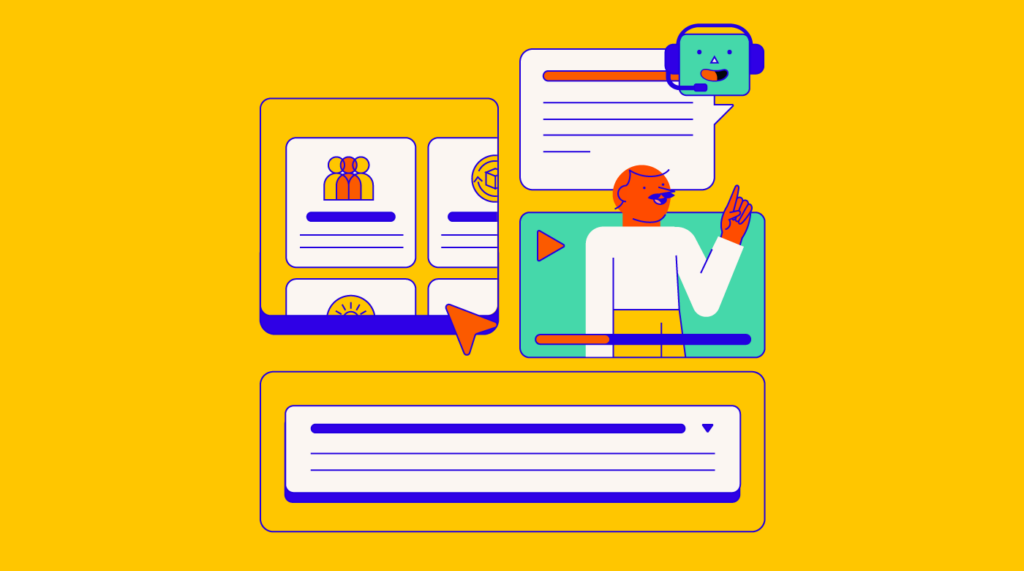As a former customer success rep, I can’t tell you how many times I got emails like this one: “I can’t get into my account. Can you reset my password?” Unfortunately, this is exactly the kind of support interaction you don’t want. Here’s why: for customers, the extra effort they’ve spent to get into their account is frustrating; for support reps, answering the same questions again and again is tiring; and for businesses, calls and chats with human agents cost more than if customers had been able to easily self service.
Fortunately, there’s good news: your customers would rather not reach out at all. 67% of customers would rather find answers through self-service than by speaking to a company rep. And self-service is growing in popularity as more consumers get comfortable with it. In 2021, 95% of companies reported a major increase in self-service requests.
But in the face of this opportunity, the state of self-service at most SaaS brands is inadequate. According to a Microsoft survey, more than half of customers say the main reason they can’t solve support issues on their own is because there’s too little information available online. 40% of customers end up calling support reps even after trying to fix their problem through self-service.
Even if your SaaS brand already has a robust self-service presence, the need for improvements never stops. In this guide, you’ll learn the key strategies and tactics to take your customer self-service to the next level. With the right approach, you can increase customer satisfaction, reduce support costs, and scale your business more efficiently.
Why Customer Self Service Is Worth The Investment
Self-service—once a “nice to have”—is now essential. 81% of customers attempt to handle support issues on their own before reaching out to customer service, and nearly half of US adults are likely to abandon a purchase if they can’t get quick answers to their questions.
With this backdrop in mind, it’s no wonder that 78% of US customer service leaders are investing more in self-service in recent years.
SaaS Brands Get Lower Support Costs and Increased Productivity
Well-trained support agents are expensive: according to a study by Oracle, a customer support call can cost your business anywhere from $6-$25 depending on the complexity of the issue. Meanwhile, when a customer finds the answers they need within FAQ pages, customer self-service portals, or help centers, it typically costs your business just a few pennies.
With this cost savings in mind, most SaaS brands focus on routing customers to self-service options wherever possible, and nudging them away from calls and live chats. Increased productivity is another benefit: with self-service handling more repetitive, common issues, agents are freed up to focus on higher-value queries. Their time can be spent on complex troubleshooting and engagement rather than repetitive tasks.
For SaaS brands, which can live or die based on recurring revenue metrics, customer loyalty may be the most critical effect of focusing on self-service. When your customers try to solve issues through self-service, but fail and end up having to call your support line, they’re 10% more likely to be disloyal. In other words, the quality of your customer self-service options has a direct impact on your customer retention.
Customers Get Quick 24/7 Help—With Less Effort
Nearly three-quarters of customers say that valuing their time is the most important aspect of customer service. Self-service options do exactly that: help centers, FAQs, and chatbots help customers solve issues faster and at their convenience, any time of day.
Reduced customer effort is another big plus. The average customer support call has multiple layers of frustration for customers: navigating menus, waiting to speak with a representative, explaining the issue, and then waiting again during transfers between departments. Help centers, on the other hand, are tailored to address the most common questions and pain points. That means less time spent searching for answers, which helps boost customer satisfaction.
Some customers simply prefer greater autonomy, and would rather not have to explain their issues or depend on an agent. Self-service gives them independence and control over resolving their own issues. With DIY options like knowledge bases and forums, customers can self-educate and find solutions for their specific use cases.
Designing An Effective Customer Self Service Strategy
Getting the most out of self-service requires an intentional strategy. A handful of FAQs isn’t enough anymore—instead, you need to cultivate a set of resources that responds directly to your customers’ needs. Here’s how:
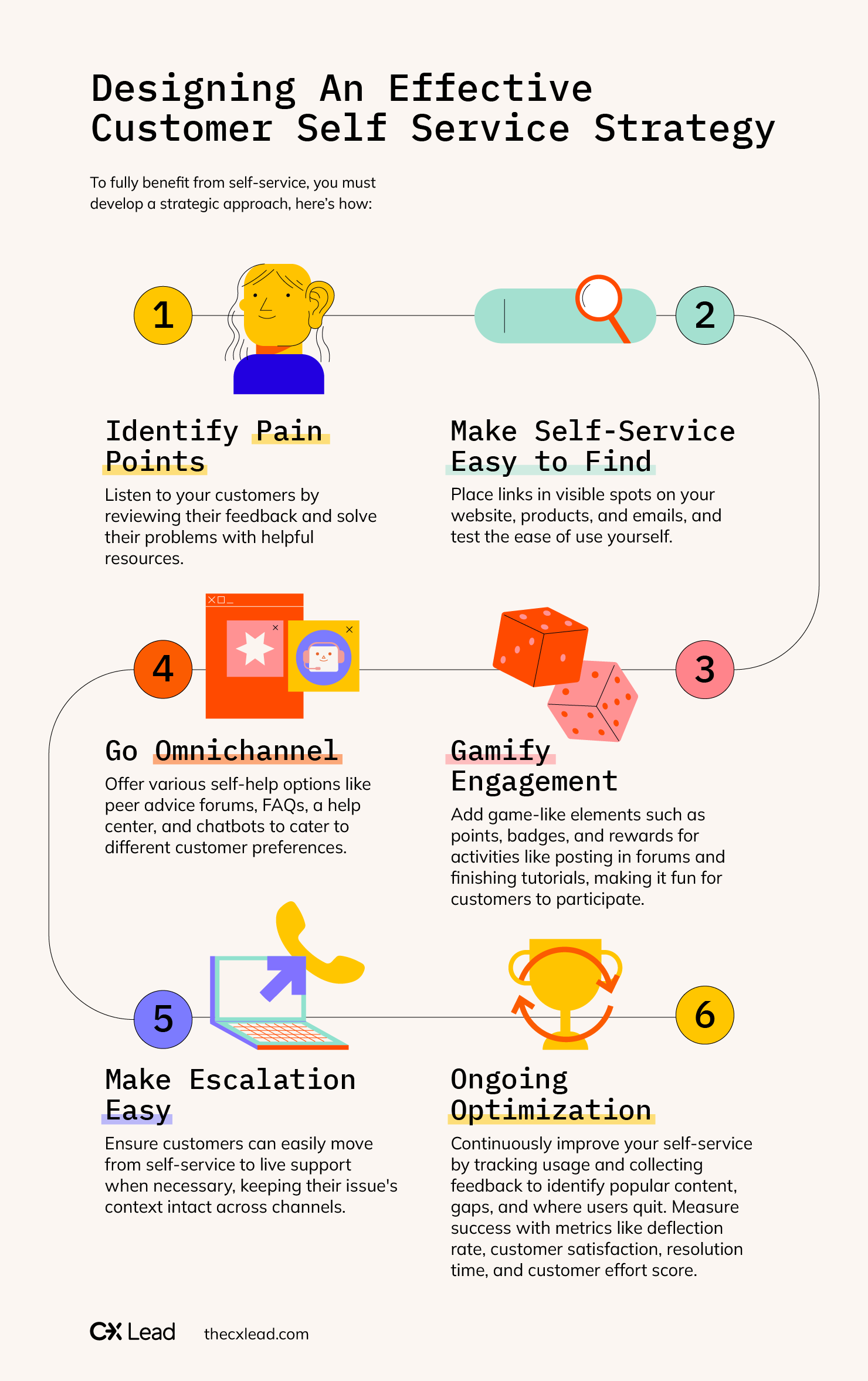
- Identify Pain Points: If you want to know how to help your customers, start by listening to them. Analyze sources like call transcripts, agent chat logs, forums, product reviews, and web searches to reveal common customer questions, pain points, and needs. Address these directly through FAQs, knowledge base articles, training, and other self-service content.
- Make Self-Service Easy to Find: Self-service content won’t help if customers can't find it. Link your self-service content prominently within your company’s website, product interface, emails, and other touchpoints. Walk through the self-service experience yourself to check for usability, and have others test it too.
- Gamify Engagement: Encourage self-service adoption through gamification techniques. Provide points, status, badges, and rewards for activities like forum posts and tutorial completion. Give customers a reason to engage.
- Go Omnichannel: Not all customers interact with self-service tools the same way. Provide a mix of self-help channels: communities for peer advice, FAQs for quick answers, a help center for troubleshooting, and chatbots for instant responses.
- Make Escalation Easy: Some issues still require human help. Make sure it’s smooth for customers to escalate from self-service to live support when needed, with context preserved between channels.
- Ongoing Optimization: Use tools like Google Analytics to monitor self-service usage patterns, watching for popular content, gaps, and drop-offs. Gather anecdotal customer data using customer feedback software, refining your customer experience based on user input. Measure the effectiveness of your self-service strategy by tracking metrics like deflection rate, customer satisfaction (CSAT), resolution time, and customer effort score (CES).
You’ll also want to keep an eye out on obstacles to self service. One challenge in particular deserves your attention: the 37% of customers who call your customer service line directly without ever seeing your self-service options. Given the dramatically increased cost of phone support as compared to self-service, reducing this percentage even a little bit can result in meaningful cost savings. One place to start, according to a report by Gartner, is by only offering your customer service phone number as an escalation option, rather than making it prominently visible across your entire website.
6 Examples Of SaaS Self Service
81% of consumers say they’d like brands to have more self-service options. If you’re considering expanding your SaaS brand’s self-service strategy, here’s where to start.
1. FAQs
Frequently Asked Questions (FAQs) are hardly an innovative self-service support tool; they’ve been around for decades. But FAQs continue to be tremendously efficient at nudging customers toward answers to common questions. By highlighting the most popular FAQs prominently on your self-service portal, you can guide customers to solutions faster. And by routinely updating your database of questions and answers based on the latest customer inquiries, you’ll reduce ticket volume and help more customers self-serve.
Example: Xero maintains a list of 50 popular FAQs, ranging from “Can I pay the subscription annually?” to “Can I download a copy of my data?”

2. Help Center
Think of your help center as a vast library of support material, including in-depth troubleshooting guides, step-by-step instructions, and how-to articles for your product. All of this information can be overwhelming, which is why it’s key to organize it clearly by categories, subtopics, and use cases; you’ll also want to integrate images, gifs, and videos to aid visual comprehension. Help desk software makes this process easier.
Example: Slack organizes its help center around broad categories like “Getting started” and “Tutorials & videos.” But the centerpiece is clearly its search function, which cleanly navigates you through Slack’s hundreds of guides and tutorials.

3. Product Training
“Show, don’t tell” is an effective teaching principle. But by the time customers have called into your support line, it’s difficult to provide visual instruction; instead, customer service representatives often rely on verbal instructions with an email follow up.
There’s a better way: product training videos. From quick video tutorials to formal virtual courses, training materials educate customers effectively, making it less likely they’ll need to call. Popular product training formats include self-paced eLearning modules, short instructional videos, animated demos, and webinars. For in-context microlearning—and another chance to reduce support volume—you can embed training materials directly into your product interface.
Example: Mailchimp provides its customers with slickly-produced training videos ranging from quick two-minute walkthroughs (”How to Preview & Test Your Email Campaign”) to half-hour masterclasses (”Design and Send an Email Campaign”).

4. Chatbots and Virtual Agents
The rise of AI-powered chatbots and virtual agents gives brands yet another low-cost self-service solution for handling routine customer inquiries. Chatbots can deflect up to 80% or more of customer inquiries without human intervention, resulting in dramatic cost savings.
By training virtual agents on company data and help center materials, and integrating them with CRM software for customer-specific context, customers can get the answers they’re looking for fast.
Example: Zoom’s virtual agent, Zoe, resolves a staggering 93% of customer inquiries without the involvement of live agents, saving Zoom more than $13 million each month.
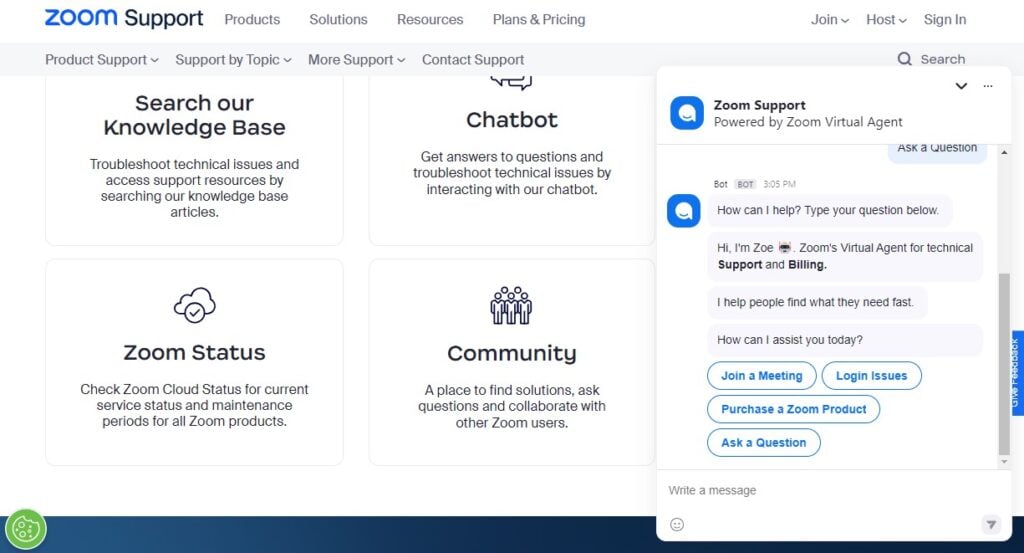
5. Community Forums
Creating articles and tutorials for every possible issue your customers might encounter is a worthy effort, but it’s beyond the abilities of most customer service teams. Luckily, there’s another way: community forums.
By letting your users ask and answer each others’ questions, you’ll reduce your support burden while gaining valuable insight into the issues customers are running into. Plus, customers often find advice from their peers to be more relatable and actionable. Make sure to have moderators in place to maintain accuracy.
Example: Dropbox’s community has north of one million members. With its built-in gamification elements, Dropbox highlights “helpful members” and encourages engagement.
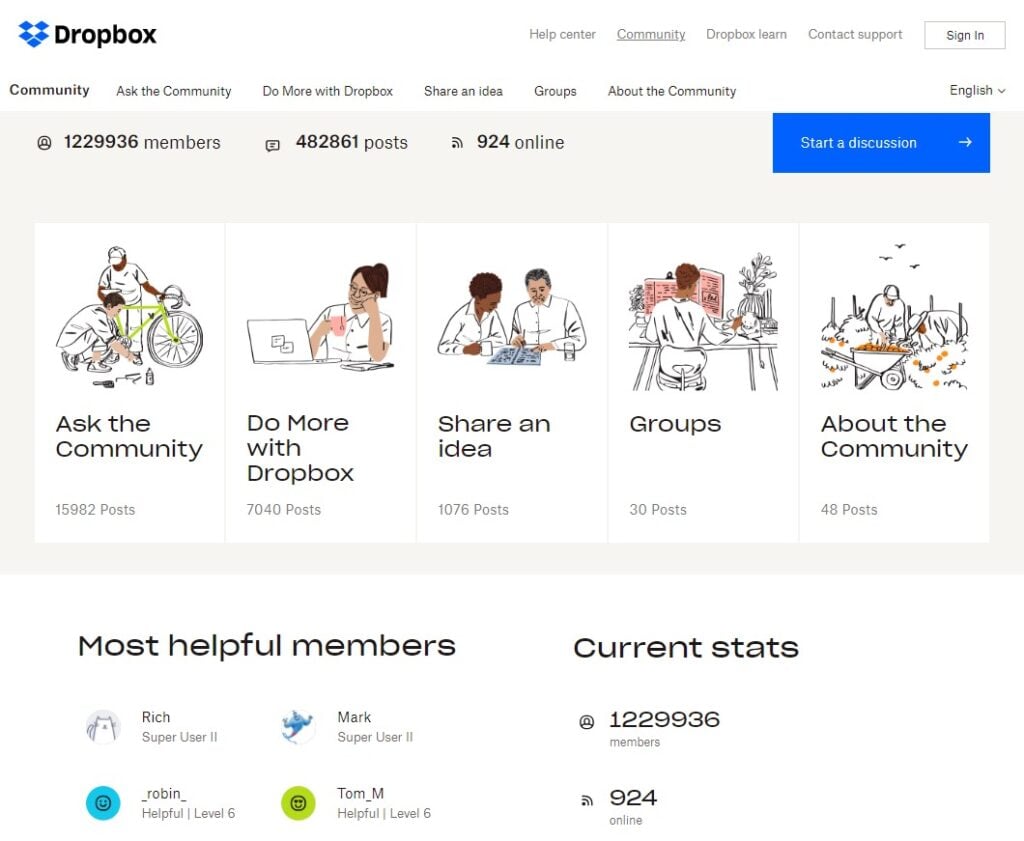
6. Customer Portal
I’m firmly in the camp of the 90% of customers who expect brands to have a self-service customer support portal. So imagine my frustration when I found myself forced to dial into an insurance company’s call center to update a simple piece of account information—only to learn that I needed to print out a PDF, sign it in ink, take a photo, and email it to customer service. What could have taken me 60 seconds ended up requiring multiple support touchpoints.
Customer portals fix messy administrative interactions like this by giving customers greater oversight of their own account. Rather than reaching out to support to update their billing information, change their subscription, or update account info, customers can make those changes directly in the portal.
Example: Canva gives users an enormous amount of control over settings in its customer portal. From adding team members to downgrading plans, almost everything related to customer accounts is driven by automation.
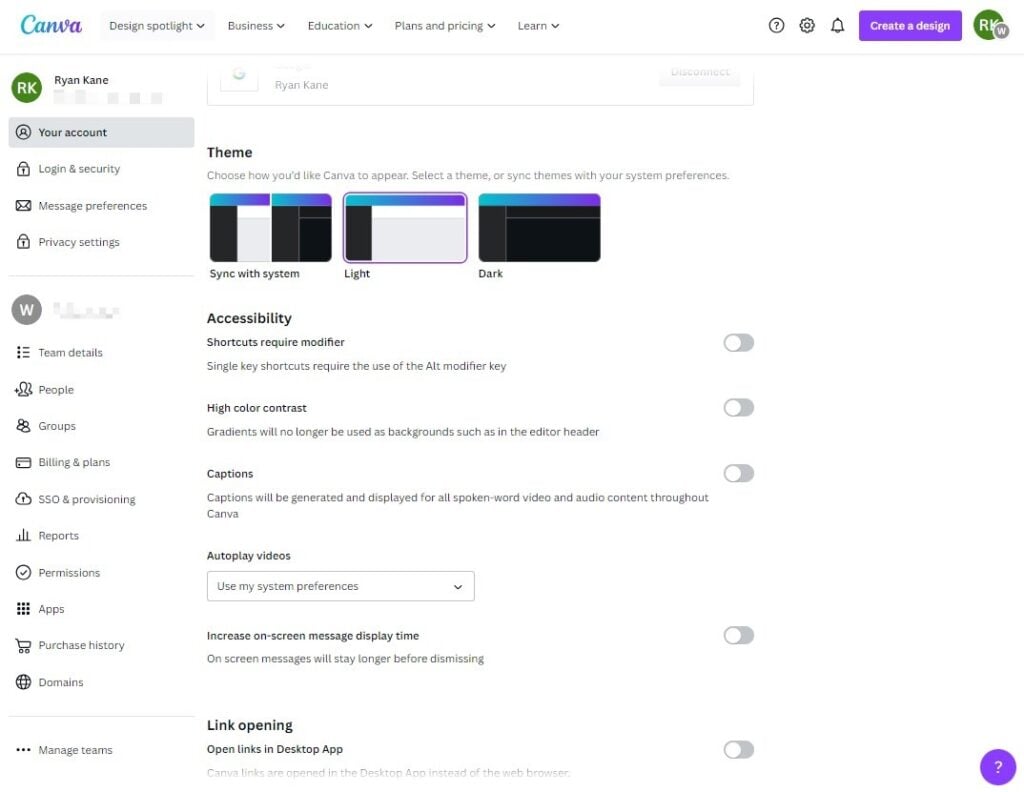
When Customers Help Themselves, Everyone Wins
By now the benefits of prioritizing customer self-service for your SaaS business should be clear. When you provide customers with the tools and resources to independently find answers, troubleshoot issues, and accomplish tasks, it's a win-win-win:
- Self-service improves customer satisfaction and loyalty by giving users the speed, autonomy, and efficiency they increasingly expect.
- This, in turn, pays dividends for your brand in the form of lower churn, higher NPS scores, and stronger brand sentiment. Meanwhile, your company gains serious efficiency and reduced costs by deflecting common inquiries to automated self-service channels.
- Plus, support reps are happier when they don’t have to deal with as many repetitive inquiries.
Ready to enhance your self-service strategy? Start with our article on the benefits of a help desk, then look through our roundup of the best AI chatbots for customer service. And make sure to subscribe to our newsletter to keep the latest CX and CS strategies and insights flowing straight to your inbox.

